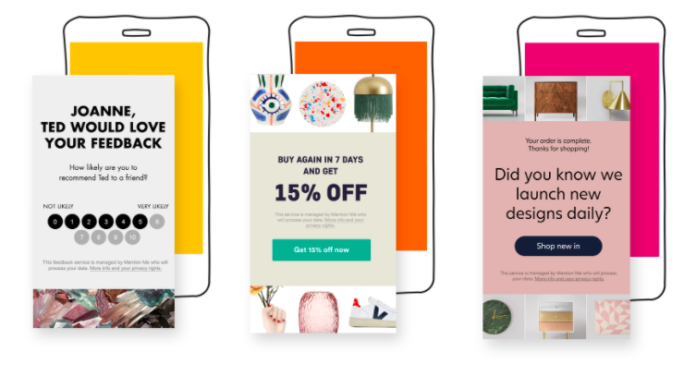5 Customer Retention Strategies to Grow Your Business
It’s 5x more expensive to acquire new customers than to keep existing ones. Increasing customer retention by 5% can increase company revenue by 25-95%. Highly engaged customers spend 60% more per transaction.

Customer retention matters. If your business isn’t prioritising it, it’s time to start.
(Not sure what your customer retention rate is? Check out the first blog in our customer retention series.)
Mention Me was founded on the belief that happy customers make successful businesses. Now, as we approach a post-Covid world with spiralling acquisition and advertising costs, that’s truer than ever.
Read on for five customer retention strategies to keep your customers coming back.
Strategy 1: Show customers you understand them
How well do you know your customers?
Chances are, not well enough. 63% say organisations should prioritise getting to know them better.
Marketers often rely on quantitative data that doesn't give the full picture. Your data may, for example, tell you that customers are most likely to open your emails and buy in the evenings, but they won’t tell you why that is.
That’s where A/B testing comes in.
By strategically segmenting customers then experimenting with elements like copy, design and touchpoints, you can drill down into what engages who. Then you can use this insight to tailor customer journeys and build brand affinity that converts into long-term revenue.
Mention Me Retain presents the right message to the right person, every time
Strategy 2: Reward customer loyalty
32% of consumers cite loyalty programmes as the best way brands can encourage them to return.
If you’re worried about what this means for your profit margins, don’t be. There are plenty of ways to reward customer loyalty without cutting prices.
Early access to sales, exclusive event invites, member-only competitions… the list goes on. Get creative with your rewards to discover what works best.
In fact, customer loyalty programmes can seriously bolster profit margins. French beauty brand Sephora drives 80% of annual sales via its Beauty Insider rewards programme.
You can also use your loyalty programme to better understand your most valuable customers. By learning what motivates them to return, you can refine messaging and more accurately target campaigns. Creating a positive cycle where customers choose your brand because they feel understood, then return as their loyalty is rewarded.
Strategy 3: Provide excellent customer service
You’re five times more likely to lose customers because of your service than product.
Yep, you read that right. Five times.
Excellent customer service is rooted in relatively simple concepts. 80% of consumers cite speed, convenience, knowledgeable help and friendly service as the most important elements of a positive customer experience.
Yet many brands fall short. We’ve all felt the frustration of repeating ourselves over and over as we’re passed between advisors asking the same questions.
NPS is a simple way to measure how customers feel about your brand's service. Better yet, you can use customers’ scores to determine which messaging to show them. Encourage promoters to recommend your brand to others; detractors to give qualitative feedback on how to improve. (Mention Me Retain can help with that.)
Provide an excellent customer service, and it won’t only be higher retention rates driving up your bottom line. One in three customers is willing to pay more for a higher level of service.
Strategy 4: Present memorable USPs
It’s not hard for brands to copy products – competitors do it all the time. It’s your brand USPs that set you apart and build customer loyalty.
Showcase the attributes that make your brand special throughout the customer journey. In the obvious places – your website, e-marketing, advertising – and the not so obvious – your small print, automated email responses and app error messages.
But keep context in mind when delivering these interactions.
Your order confirmation page, for example, can be humorous and fun; your emails about a delayed delivery should be sincere and informative. (EE learnt that the hard way when it blamed 'gremlins in the system' for a network outage back in 2014.)
Presenting a brand consistently across all platforms can increase revenue by up to 23%. Show customers you understand them and they’ll return, over and over again.
Strategy 5: Build a brand community
Your brand’s most powerful marketing doesn’t come from your marketing team – it comes from your customers. Build communities around your happy customers and they’ll do the talking for you.
Look at Nike. By engaging, rewarding and inspiring NikePlus members, it’s built a global community of dedicated brand fans. It even opened a concept store for NikePlus members in 2018, using their data – buying patterns, app usage and other trends – to determine decisions such as stock.
Building a brand community might feel less results-driven than performance marketing channels, but it’s a forward-thinking strategy that pays dividends in the long-term.
Word of mouth is the most powerful marketing channel out there. 40% of consumers spend more when part of a brand community. Meaningful brands outperform the stock market by 134%.
Once you’ve built your brand community, measure its impact. Understand why members love your brand, and use this to drive action from other customers. Deliver value to your customers, and they’ll deliver even more long-term value back.